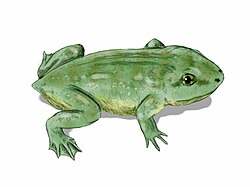| Rhinatrema | |
|---|---|
| Scientific classification | |
| Kingdom: | Animalia |
| Phylum: | Chordata |
| Class: | Amphibia |
| Order: | Gymnophiona |
| Clade: | Apoda |
| Family: | Rhinatrematidae |
| Genus: | Rhinatrema Duméril and Bibron, 1841 |
| Type species | |
| Caecilia bivittata Guérin-Méneville, 1838 | |

Rhinatrema is a genus of caecilians in the family Rhinatrematidae. [1] [2] Their common name is two-lined caecilians. The genus is known from the Guyanas (Guyana, French Guiana, and Suriname) and adjacent Brazil. [1] Most Rhinatrema are known to inhabit and live in areas of tropical forests where there is an abundance of dense, dead vegetation matter. [3]
Rhinatrema are primitive caecilians that have a true tail. They are oviparous. [4]
Until recently, the two-lined caecilian (R. bivittatum) was the only species in the genus Rhinatrema. However, in 2010 and 2018, new species were described. The genus now contains now seven species: [1] [2]
| Binomial name and author | Distribution | Status |
|---|---|---|
| Rhinatrema bivittatum (Guérin-Méneville, 1838) | Guyana, Surinam, French Guiana, Brazil | Least Concern [5] |
| Rhinatrema gilbertogili Maciel, Sampaio, Hoogmoed, and Schneider, 2018 | Brazil | Not evaluated |
| Rhinatrema koki Wilkinson & Bittencourt-Silva, 2025 [6] | Guyana | Not evaluated |
| Rhinatrema nigrum Dunn, 1942 | Guyana, Venezuela, possibly Brazil | Least Concern [7] |
| Rhinatrema ron Wilkinson and Gower, 2010 | Brazil | Not evaluated |
| Rhinatrema shiv Gower, Wilkinson, Sherratt, and Kok, 2010 | Guyana | Not evaluated |
| Rhinatrema uaiuai Maciel, Sampaio, Hoogmoed, and Schneider, 2018 | Brazil | Not evaluated |



